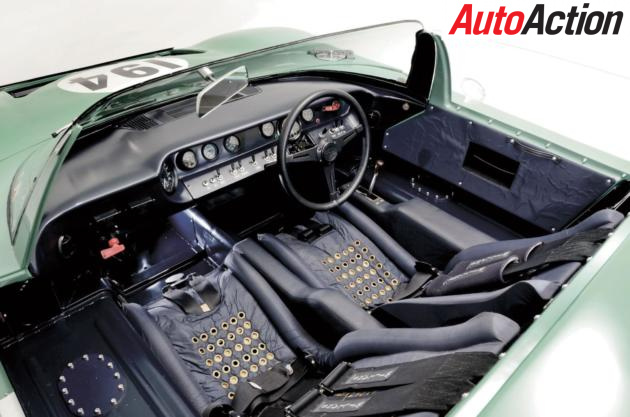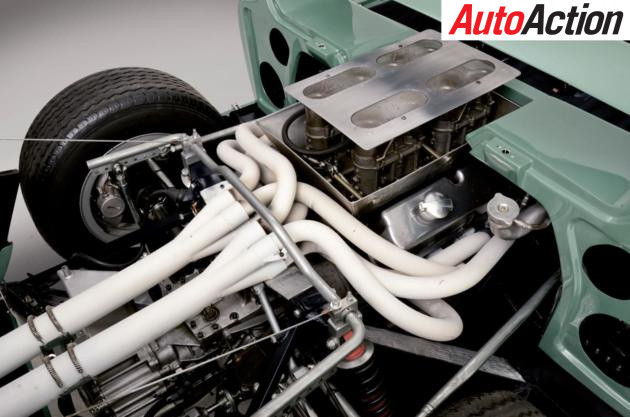Rare Ford GT40 to Race at Phillip Island


Ford built only a dozen GT prototypes, and one of them is headed Down Under
By DAVID HASSALL
ONE OF the most famous Ford GT40s in the world – discovered after going missing for 40 years – will be a star attraction at this year’s Phillip Island historic meeting on March 17-19.
A rare open-cockpit version of the iconic sports-racing car that dominated Le Mans in the second half of the 1960s, chassis #111 is one of only five roadsters built and is distinguished by its unusual green colour.

It is one of the original 12 pre-production prototypes built by Ford after the American company decided to beat Ferrari at Le Mans; seven were closed cars and five were roadsters. Only four roadsters survived and this is one of three to have been raced by the works, making it one of the rarest and most desirable Ford GT40s in the world.
The car will be raced at Phillip Island by regular driver Pedro Silva, the son of the car’s owner, Joao Silva.
Gelscoe Motorsport, one of the world’s foremost GT40 experts, discovered the car in 2006, advised Joao of its availability and then restored it for him to original specifications in just nine months. The detail of the restoration is exacting, with the correct blue monocoque and matching parachute-material seats (production cars – which carried four-digit numbers – were black).

GT/111 was originally constructed by Ford Advanced Vehicles (FAV) in the UK in early 1965 and sent to the Le Mans pre-race trials in April.
It was powered by a 289 cubic-inch (4.7-litre) Shelby Cobra engine and fitted with one of the first ZF five-speed gearboxes, which replaced the troublesome Colotti four-speed used since the Ford GT’s debut in 1964.
Works driver John Whitmore found the roadster five seconds slower than the coupe at Le Mans – not surprising considering the turbulence that would have slowed it down the long Mulsanne Straight – but the team sent it to the Targa Florio as its only entry, judging the open cockpit would be cooler for the torturous 700km road race.

Legendary team boss John Wyer paired Whitmore with American Bob Bondurant in the Targa Florio, which consisted of 10 laps of the island of Sicily on the tip of Italy. The car was painted ‘Linden Green’ and given the number 194.
GT/111 ran as high as third despite firing on only seven cylinders, but at half-distance a knock-off spinner came undone and Whitmore lost a front wire wheel, at which point some Italian comedy ensued.
The wheel bounded in the air and took out an overhead electric wire for the adjoining rail line, requiring Whitmore to recover the Halibrand from the countryside while a policeman had to retrieve the spinner from a reluctant souvenir hunter, though only after a heated argument.
Other spectators were more co-operative. There was no jack in the car, so they lifted the front of the GT40 while Whitmore refitted the recalcitrant wheel.

After returning to the pits, where a loose front roll bar was disconnected, ensuring plenty of oversteer, Bondurant took over and moved back up the standings until, on the penultimate lap, he lost it on some loose gravel and hit a kilometre marker so hard it ripped off the very wheel Whitmore had lost earlier. Damage was bad enough to end GT/111’s one and only race while Bondurant retired to the nearest bar for a stiff drink.
When it came to production of the GT40, Ford dismissed the idea of a roadster and, despite the fact it was repairable, GT/111 languished in the back of the FAV factory, where it was gradually stripped of usable parts. Then one morning FAV workers arrived to find the yard had been cleaned up and chassis #111 had been removed by the scrap merchant.
It was presumed destroyed for more than 40 years, but in September 2006 Gelscoe mechanics were working on a GT40 in the paddock when a passerby remarked, “I’ve got a GT40.”
The mechanics allegedly kept on working, but the spectator continued: “Ours is in need of restoration. We’ve had it for years… it’s for sale, if you’re interested.”
Phone numbers were exchanged and a few days later the car was inspected in an East London lock-up, resting on an old mattress that had kept it off the ground and from rusting away.
It had no top and the windshield had been cut away, but it was clearly something special. For one thing, all the support ribs in the pontoons were perforated steel, which was unique to the 12 prototypes. A price was agreed, and then the seller produced the chassis plate GT/111…
The car was inspected and authenticated by GT40 authority Ronnie Spain, who wrote that he was “extremely happy that after all this time one of the missing GT40 chassis has finally come out of the woodwork”.









